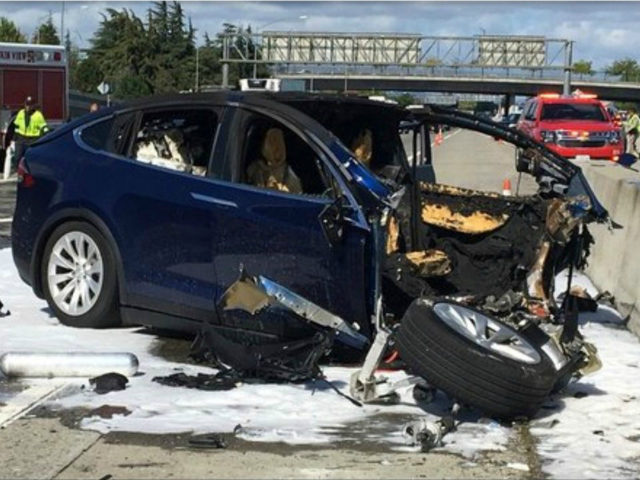Tesla has reportedly settled a lawsuit filed by the family of an Apple engineer who died in a 2018 crash involving the company’s controversial Autopilot technology, according to court filings on Monday.
The Mercury News reports that on March 23, 2018, a devastating crash on Highway 101 in Mountain View, California, claimed the life of Walter Huang, a 38-year-old software engineer at Apple and devoted family man. Huang was driving his Tesla Model X SUV with the company’s Autopilot system engaged when the vehicle veered into a highway barrier. Investigators later discovered that Huang had been playing a video game on his phone moments before the fatal collision.
Breitbart News previously reported on the crash, including the fact that Huang had complained about Autopilot problems in the past on the same stretch of road:
KQED reports that an Apple engineer was recently killed when his Tesla Model X vehicle collided with a concrete barrier along the freeway, but there is now evidence that he had previously complained about the vehicle’s autopilot system malfunctioning on that same stretch of road. The engineer’s complaints were released in a trove of documents released by the National Transportation Safety Board (NTSB) recently.
The crash, which killed Walter Huang, 38, in March 2018 took place near Mountain View, California, and is being investigated by the NTSB. The board is also investigating a crash in Delray Beach, Florida, that happened approximately one year later in which another driver, Jeremy Banner, was killed.
In the wake of the tragedy, Huang’s wife took legal action against Tesla in 2019, filing a lawsuit in Santa Clara County Superior Court. The suit, which sought damages on behalf of the widow and the couple’s two young children, alleged that the 2017 Tesla Model X Huang was driving lacked adequate safety features and was prone to colliding with common roadway obstacles when Autopilot was activated.
As the case was set to go to trial this week, court filings on Monday revealed that Tesla had reached a settlement agreement with the Huang family. The terms of the settlement, including the financial compensation, remain confidential. Tesla has not issued a public statement regarding the resolution of the lawsuit.
The Huang case is just one example of the legal and regulatory challenges Tesla has faced since introducing its Autopilot feature in 2015. The software, which comes standard on all Tesla vehicles, offers varying levels of assistance, from basic cruise control and steering support to more advanced features like automated lane changes and navigation. However, critics argue that the technology, and Tesla’s marketing of it, may lead drivers to place too much trust in the system and fail to maintain proper attention on the road.
Studies, such as a 2019 survey conducted by the Insurance Institute for Highway Safety, have shown that Tesla’s Autopilot is more likely than other manufacturers’ driver-assistance systems to foster a false sense of security among drivers, leading them to believe they can safely remove their hands from the wheel.
Regulatory bodies, including the National Highway Transportation Safety Administration (NHTSA), have launched investigations into Autopilot’s role in various accidents. The agency has been examining the technology since August 2021, initially focusing on collisions involving Tesla EVs on Autopilot and parked emergency vehicles. The scope of the investigation has since expanded to consider how Autopilot may contribute to human error and unsafe driving behaviors.
In Huang’s case, Tesla’s data indicated that Autopilot had, on four separate occasions in the month leading up to the crash, steered the vehicle slightly to the left at the same location where Huang’s fatal accident occurred. While Huang had managed to correct the vehicle’s course each time, Tesla claimed that he had been increasingly relying on Autopilot and spending more time with his hands off the wheel, ultimately leading to what the company described as “extraordinary misuse” of the system.
Court filings also revealed that Huang had activated Autopilot approximately 19 minutes before the crash, setting the speed at 75 mph. Tesla’s data showed that Huang had received multiple visual and audible warnings to place his hands back on the wheel in the minutes leading up to the collision, with no hands detected on the wheel in the final six seconds.
In settling the lawsuit, Tesla expressed its desire to conclude the lengthy litigation process. The company’s decision to keep the settlement amount private was driven by concerns that publicizing the figure could complicate future legal proceedings.
Read more at the Mercury News here.
Lucas Nolan is a reporter for Breitbart News covering issues of free speech and online censorship.


COMMENTS
Please let us know if you're having issues with commenting.